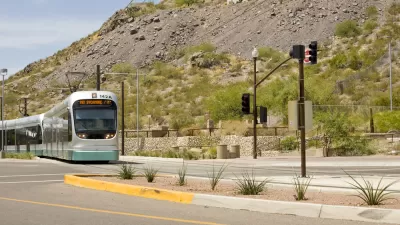The rivalry between Dallas and Houston is well known, but Dug Begley recently made a compelling comparison between the two cities: their approach to commuter rail.

"When it comes to rail development…it's not just miles, but long-running philosophies dating back more than 30 years that divide Houston and Dallas as both open new rail lines this year," writes Begley.
The comparison is especially apt as Houston prepares to open new Purple and Green lines (expected in the fall) and a new Dallas Area Rapid Transit line brings rail to the region's major airport (expected in August).
"Since 1983, and some argue even longer than that, the cities have been on vastly different trajectories when it comes to rail transit. Dallas has enjoyed a much less fractious political climate. That relative calm compared to Houston has given Dallas officials more latitude to invest and leverage local money to capture federal funds."
That tradition has led to the more dense of the two having less rail transit service: "DART will soon have 90 miles serving 62 stations, while Houston later this year will have 22 miles of track and 38 major stops….Houston's population is twice that of Dallas, though their respective metropolitan areas are similar in size."
The article is a good, long piece, with plenty of detail and opinions from either side of the debate about transit and rail in particular.
FULL STORY: Dallas, Houston follow different paths on rail development

Planetizen Federal Action Tracker
A weekly monitor of how Trump’s orders and actions are impacting planners and planning in America.

Map: Where Senate Republicans Want to Sell Your Public Lands
For public land advocates, the Senate Republicans’ proposal to sell millions of acres of public land in the West is “the biggest fight of their careers.”

Restaurant Patios Were a Pandemic Win — Why Were They so Hard to Keep?
Social distancing requirements and changes in travel patterns prompted cities to pilot new uses for street and sidewalk space. Then it got complicated.

Platform Pilsner: Vancouver Transit Agency Releases... a Beer?
TransLink will receive a portion of every sale of the four-pack.

Toronto Weighs Cheaper Transit, Parking Hikes for Major Events
Special event rates would take effect during large festivals, sports games and concerts to ‘discourage driving, manage congestion and free up space for transit.”

Berlin to Consider Car-Free Zone Larger Than Manhattan
The area bound by the 22-mile Ringbahn would still allow 12 uses of a private automobile per year per person, and several other exemptions.
Urban Design for Planners 1: Software Tools
This six-course series explores essential urban design concepts using open source software and equips planners with the tools they need to participate fully in the urban design process.
Planning for Universal Design
Learn the tools for implementing Universal Design in planning regulations.
Heyer Gruel & Associates PA
JM Goldson LLC
Custer County Colorado
City of Camden Redevelopment Agency
City of Astoria
Transportation Research & Education Center (TREC) at Portland State University
Camden Redevelopment Agency
City of Claremont
Municipality of Princeton (NJ)





























